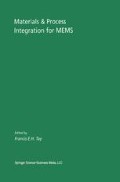Abstract
This chapter describes an in-situ trench etching and release technique to fabricate high aspect-ratio beams for high performance MEMS accelerometers using the Sio2 etching mask from Magnetically Enhanced Reactive Ion Etcher (MERLE). Work has started from comparison of the profiles of trenches masked by Sio2 to those masked by Si3N4 in forming MEMS structures. In our experimental conditions using HBr/SiF4/O2 in MERLE, the etching process with the Sio2 mask was proven to be able to form deeper anisotropic trenches than that with the the Si3N4 mask. Amount of oxygen available from the etching gas and/or the mask appeared to be a major factor controlling the floor etching of trenches as well as the sidewall passivation of beams. Excessive oxygen generated from the Sio2 mask led to sidewall encroachment of the beams. On the other hand, lack of oxygen in the Si3N4 mask resulted in etch-stopping and micro-grassing, before forming the high-aspect-ratio MEMS structures. In the conventional process, lateral encroachment due to the release etching was severe underneath the Sio2 mask. In the in-situ process developed in this research, the sidewall of the beams was passivated by inhibiting layers formed during the HBr/SiF4/O2 trench etching, and the beams were not attacked by the subsequent SF6 release etching. Major constituents of the passivating layers that were produced by the in-situ process were Si and O. The in-situ process dispensed with both sidewall deposition and floor etching steps of the conventional process. Dependency of etching rates on open-ratio and pattern-size was studied in MERLE for high aspect-ratio MEMS structures. The etching rates of Si substrate in MERLE remained unchanged despite a change in the overall open-ratio on the wafer in the range of 10% to 50%, and this was different from the results of an ICE etcher.
Access this chapter
Tax calculation will be finalised at checkout
Purchases are for personal use only
Preview
Unable to display preview. Download preview PDF.
References
Y. X. Li, P. J. French, P. M. Sarro and R. F. Wofffenbuttel. SIMPLE — A technique of silicon micromachining using plasma etching. Sensors and Actuators, 1996; A57: 223.
A. A. Ayon, X. Zhang and R. Khanna. Anisotropic silicon trenches 300–500 gm deep employing Time Multiplexed Deep Etching (TMDE). Sensors and Actuators, 2001; A91: 381.
A. A. Ayon, K. Ishihara, R. A. Braff, H. H. Sawin and M. A. Schmidt. Microfabrication and testing of suspended structures compatible with silicon-on-insulator technology. J. Vac. Sci. Technol., 1999; B17: 1589.
J. W. Weigold, W. H. Juan and S. W. Pang. Etching of boron diffusion of high aspect ratio Si trenches for released resonators. J. Vac. Sci. Technol., 1997; B15: 267.
K. W. Kok, W. J. Yoo and K. Sooriakumar. In situ trench etching and releasing techniques of high aspect ratio beams using MERLE. J. Vac. Sci. Technol., 2002; B20: 154.
K. R. Williams and R. S. Muller. Etch rates for micromachining processing. J. Microelectromechanical Systems, 1996; 5, No 4, 56.
J. M. Lane, K. H. A. Bogart, F. P. Klemens and J. T. C. Lee. The role of feedgas chemistry, mask materials, and processing parameters in profile evolution during plasma etching of Si(100), J.Vac. Sci. Technol., 2000; A18: 2067.
R. F. Wolffenbuttel, J. F. L. Goosen and P. M. Sarro. Design considerations for a permanent-rotor-charge-excited micromotor with an electrostatic bearing, Sensors and Actuators, 1991; A 27: 583.
K. A. Shaw, Z. L. Zhang and N. C. MacDonald. SCREAM I: a single mask, single-crystal silicon, reactive ion etching process for microelectromechanical structures, Sensors and Actuators, 1994; A 40: 63.
F. Laermer and A. Schilp. Method of Anisotropically Etching Silicon,United States Patent No. 5501893.
J. Bhardwaj, H. Ashraf and A. McQuarrie. Dry silicon etching for MEMS. Proc. Third International Symposium on Microstructures and Microfabricated Systems, 4 – 9 May 1997; 118, Montreal, Canada.
S. Y. Koh, K. W. Kok, C. S. Sem, W. J. Yoo and K. Sooriakumar. Role of oxygen in etching of high-aspect-ratio deep trenches for MEMS applications. Proc. International MEMS Workshop 2001, 4th-6th July, 2001, 286, Singapore.
D. L. Flamm, Plasma Etching: An Introduction. Academic Press Inc., 1989.
C. Steinbruchel. Universal energy dependence of physical and ion-enhanced chemical etch yields at low ion energy, Appl. Phys. Lett., 1989; 55: 1960.
F. H. Bell and O. Joubert. Polysilicon gate etching in high density plasmas. V. Comparison between quantitative chemical analysis of photoresist and oxide masked polysilicon gates etched in HBr/C12/02 plasmas. J. Vac. Sci. Technol., 1997; B15: 88.
G. S. Oehrlein, J. F. Rembetski and E. H. Payne. Study of sidewall passivation and microscopic silicon roughness phenomena in chlorine-based reactive ion etching of silicon trenches. J. Vac. Sci. Technol., 1990; B8: 1199.
J. Karttunen, J. Kiihamaki and S. Franssila. Loading effects in deep silicon etching. Proc. SPIE, 2000; 4174: 90.
Author information
Authors and Affiliations
Editor information
Editors and Affiliations
Rights and permissions
Copyright information
© 2002 Springer Science+Business Media New York
About this chapter
Cite this chapter
Yoo, W.J., Kok, K.W., Koh, S.Y. (2002). Plasma Etching Techniques to Form High-Aspect-Ratio MEMS Structures. In: Tay, F.E.H. (eds) Materials & Process Integration for MEMS. Microsystems, vol 9. Springer, Boston, MA. https://doi.org/10.1007/978-1-4757-5791-0_14
Download citation
DOI: https://doi.org/10.1007/978-1-4757-5791-0_14
Publisher Name: Springer, Boston, MA
Print ISBN: 978-1-4419-5303-2
Online ISBN: 978-1-4757-5791-0
eBook Packages: Springer Book Archive

